Research on Optimal Operation of Regional Integrated Energy Systems in View of Demand Response and Improved Carbon Trading
Abstract
:1. Introduction
2. RIES Model with DR and ICTM
2.1. RIES Structure
2.2. DR Model
- Translatable load
- 2.
- Shiftable load
2.3. Structure of the Improved Carbon Trading Mechanism
2.4. Improved User Satisfaction
3. Model of Main Equipment
3.1. Gas Turbine
3.2. Waste Heat Boilers and Electric Boilers
3.3. Gas Boiler
3.4. Electric Chiller and Absorption Chiller
3.5. Electric Vehicles
4. Optimal Operation Model of the RIES System
4.1. Objective Function
4.1.1. Energy Interaction Cost
4.1.2. Carbon Transaction Cost
4.1.3. Operation and Maintenance Cost
4.1.4. Environmental Benefit Cost
4.2. Constraint Conditions
4.3. Solution Method
5. Example Analysis
5.1. Data
5.2. Electric Vehicle Load
5.2.1. Monte Carlo Method
5.2.2. Improved Genetic Algorithm
5.3. Result Analysis
6. Conclusions
- Under the carbon trading mechanism, considering the demand response, it not only shifts the peak load to the valley period, reduces the load energy consumption, and realizes the role of peak regulation and valley filling, but also realizes the mutual substitution, coupling, and smoothing of the load curves of electric energy and thermal energy, cold energy, and gas energy at the user side, and the shift of peak load to valley load greatly reduces the system energy consumption cost.
- The improved genetic algorithm is used to optimize the orderly charging method of EV charging, reducing the peak-to-valley difference by 23.06%, which can reduce the impact of excessive EV load on the system and achieve stable grid operation.
- The total operating cost of the RIES system with demand response considered decreased by 6.20% compared to the RIES without demand response considered; the total operating cost of the RIES with demand response considered decreased by 10.47%; and the overall cost of the RIES with demand response considered under the carbon trading mechanism proposed in this paper decreased by 16.13%, indicating that the economy of the system was greatly improved and the operating cost savings were achieved.
- The RIES system considering demand response reduces the carbon trading cost by 6.28% compared to the RIES without consideration and reduces the carbon trading cost of the grid by 80.5% compared to the RIES with consideration of the carbon trading mechanism. The RIES system considering demand response under the carbon trading mechanism proposed in this paper reduces the carbon trading cost by 83.10%, indicating that the environmental friendliness of the system is improved, which facilitates the reduction of carbon emissions and achieves the purpose of a low-carbon system.
Author Contributions
Funding
Institutional Review Board Statement
Informed Consent Statement
Data Availability Statement
Conflicts of Interest
Nomenclature
| WT | Wind turbine. |
| PV | Photovoltaics. |
| EV | Electric vehicle. |
| GT | Gas turbine. |
| GB | Gas-fired boiler. |
| EB | Electric boiler. |
| WHB | Waste heat boiler. |
| AC | Absorption chiller. |
| EC | Electric chiller. |
| The load variation at moment m after DR. | |
| Initial load. | |
| Electricity price variation at time n after DR. | |
| The initial price at time n. | |
| Initial load reduced at time m. | |
| Electricity price at time n. | |
| The CL price demand elasticity matrix and the SL price demand elasticity matrix. | |
| The thermal and electrical power of the gas turbine at time t; the thermal power of the gas boiler at time t. | |
| Energy trading with the grid. | |
| Output thermal power of an electric boiler; Minimum and maximum output power of an electric boiler. | |
| Heat power of waste heat boilers and gas-fired boilers; the minimum and maximum output power of the gas turbine. | |
| The input of a gas boiler. | |
| The input and output power of the electric refrigerator; the minimum and maximum input power of the electric refrigerator. | |
| The input and output of the electric chiller; the minimum and maximum output of the electric chiller. | |
| The amount of electricity and gas purchased at the time t. | |
| Power generation and consumption of each piece of equipment; user electrical load demand. | |
| Heat release and heat storage power of the heat storage tank. |
References
- Li, P.; Wang, Z.X.; Yang, W.H.; Liu, H.T.; Yin, Y.X.; Wang, J.H.; Guo, T.Y. Hierarchically partitioned coordinated operation of distributed integrated energy system based on a master-slave game. Energy 2021, 214, 119006. [Google Scholar] [CrossRef]
- Zhou, Y.H.; Ge, F.; Dai, G.; Yang, Q.B.; Zhu, H.; Youssefi, N. Modified Arithmetic Optimization Algorithm: A new Approach for Optimum Modeling of the CCHP system. J. Electr. Eng. Technol 2022, 17, 3223–3240. [Google Scholar] [CrossRef]
- Li, P.; Zhang, F.; Ma, X.Y.; Yao, S.J.; Wu, Y.H.; Yang, P.; Zhao, Z.L.; Lai, L.L. Operation Cost Optimization Method of Regional Integrated Energy System in Electricity Market Environment Considering Uncertainty. J. Mod. Power Syst. Clean Energy 2023, 11, 368–380. [Google Scholar] [CrossRef]
- Wang, Y.L.; Wang, Y.D.; Huang, Y.J.; Yu, H.Y.; Du, R.T.; Zhang, F.L.; Zhang, F.W.; Zhu, J.R. Optimal Scheduling of the Regional Integrated Energy System Considering Economy and Environment. IEEE Trans. Sustain. Energy 2019, 10, 1939–1949. [Google Scholar] [CrossRef]
- Sun, P.R.; Hao, X.J.; Wang, J.; Shen, D.; Tian, L. Low-carbon economic operation for integrated energy system considering carbon trading mechanism. Energy Sci. Eng. 2021, 9, 2064–2078. [Google Scholar] [CrossRef]
- Cui, Y.; Xiu, Z.J.; Liu, C. Dual level optimal dispatch of power system considering demand response and pricing strategy on deep peak regulation. Proc. IEEE 2021, 41, 4403–4415. [Google Scholar]
- Kong, X.Y.; Sun, F.Y.; Huo, X.X.; Li, X.; Shen, Y. Hierarchical optimal scheduling method of heat-electricity integrated energy system based on Power Internet of Things. Energy 2020, 210, 118590. [Google Scholar] [CrossRef]
- Gong, X.; Li, F.; Sun, B. Collaborative Optimization of Multi-Energy Com-plementary Combined Colling, Heating, and Power Systems Considering Schedulable Loads. Energies 2020, 13, 918. [Google Scholar] [CrossRef]
- Jiang, Z.Q.; Ai, Q.; Hao, R. Integrated Demand Response Mechanism for Industrial Energy System Based on Multi-Energy Interaction. IEEE Access 2019, 7, 66336–66346. [Google Scholar] [CrossRef]
- Michiel, H.W.; Negenborn, R.R.; Schutter, B.D. Demand Response With Micro-CHP Systems. Proc. IEEE 2011, 99, 200–213. [Google Scholar]
- Zhao, H.P.; Miao, S.H.; Li, C. Research on Optimal Operation Strategy for Park-level Integrated Energy System Considering Cold-heat-electric Demand Coupling Response Characteristics. Proc. CSEE 2022, 42, 573–589. [Google Scholar]
- Yang, H.Z.; Li, M.L.; Jiang, Z.Y. Optimal Operation of Regional Integrated Energy System Considering Demand Side Heating Loads Response. Power Syst. Protec. Cont. 2020, 48, 30–37. [Google Scholar]
- Said, D.; Mouftah, H.T. A Novel Electric Vehicles Charging/Discharging Management Protocol Based on Queuing Model. IEEE Trans. Intell. Veh. 2020, 5, 100–111. [Google Scholar] [CrossRef]
- Liu, H.; Zhao, M.X.; Ge, S.Y. Sequential Power Flow Calculation of Power-heat Integrated Energy System Based on Refined Heat Network Model. Auto. Electr. Power Syst. 2021, 45, 63–72. [Google Scholar]
- Jin, J.L.; Zhou, C.Y.; Guo, X.J.; Zhang, M.M. Low-carbon power dispatch with wind power based on carbon trading mechanism. Energy 2017, 170, 250–260. [Google Scholar] [CrossRef]
- Yin, Y.; Liu, F.C. Carbon Emission Reduction and Coordination Strategies for New Energy Vehicle Closed-Loop Supply Chain under the Carbon Trading Policy. Complexity 2021, 2021, 3720373. [Google Scholar] [CrossRef]
- Abappour, S.; Mohammadi-Ivatloo, B.; Hagh, M.T. Robust bidding strategy for demand reponse aggregators in electricity market based on game theory. J. Clean. Prod. 2020, 243, 118393. [Google Scholar] [CrossRef]
- Huang, W.J.; Zhang, N.; Kang, C.Q.; Li, M.X.; Huo, M.L. From demand response to integrated demand response: Review and prospect of research and application. Prot. Control. Mod. Power Syst. 2019, 4, 12. [Google Scholar] [CrossRef]
- Go, H.S.; Ryu, J.H.; Kim, J.W.; Kim, G.D.; Kim, C.H. New Prediction of the Number of Charging Electric Vehicles Using Transformation Matrix and Monte-Carlo Method. J. Electr. Eng. Technol. 2017, 12, 451–458. [Google Scholar] [CrossRef]
- Wang, H.L.; Zhang, Y.J.; Mao, H.P. Charging load forecasting method based on instantaneous charging probability for electric vehicles. Electr. Power Auto. Equip. 2019, 39, 207–213. [Google Scholar]
- Chen, Z.Q.; Sun, Y.Y.; Ai, X.; Sarmad, M.M.; Yang, L.P. Integrated Demand Response Characteristics of Industrial Park: A Review. J. Mod. Power Syst. Clean Energy 2020, 8, 15–26. [Google Scholar] [CrossRef]
- Asadinejad, A.; Tomsovic, K. Optimal use of incentive and price based demand response to reduce costs and price volatility. Electr. Power Syst. Res. 2017, 144, 215–223. [Google Scholar] [CrossRef]
- Mohseni, M.; Rabiee, A. Voltage stability constrained multi-objective optimal reactive power dispatch under load and wind power uncertainties: A stochastic approach. Renew. Energy 2016, 31, 598–609. [Google Scholar] [CrossRef]
- Qu, K.P.; Huang, L.N.; Yu, T.; Zhang, H.S. Decentralized Dispatch of Multi-area Integrated Energy Systems with Carbon Trading. Proc. CSEE 2018, 38, 697–707. [Google Scholar]
- Wang, J.; Xing, H.J.; Wang, H.X.; Xie, B.J.; Luo, Y.F. Optimal Operation of Regional Integrated Energy System Considering Integrated Demand Response and Exergy Efficiency. J. Electr. Eng. Technol. 2022, 17, 2591–2603. [Google Scholar] [CrossRef]
- Wang, R.; Cheng, S.; Zuo, X.W.; Liu, Y. Optimal management of multi stakeholder integrated energy system considering dual incentive demand response and carbon trading mechanism. Int. J. Energy Res. 2021, 46, 6246–6263. [Google Scholar] [CrossRef]
- Ma, Y.C.; Wang, S.T.; Liu, R.M. Research on Coordinated Control Strategy of DC Microgrid With Wind-energy Storage Considering User’s Satisfaction. Power Syst. Technol. 2022, 46, 3094–3107. [Google Scholar]
- Sun, X.M.; Wang, W.; Su, S. Coordinated Charging Strategy for Electric Vehicles Based on Time-of-use Price. Auto. Electr. Power Syst. 2013, 37, 191–195. [Google Scholar]
- He, L.C.; Lu, Z.G.; Geng, L.J.; Zhang, J.F.; Li, X.P.; Guo, X.Q. Environmental economic dispatch of integrated religional energy system considering integrated demand response. INT. J. Elec. Power 2019, 116, 105525. [Google Scholar] [CrossRef]
- Xing, Y.; Li, F.; Sun, K.; Wang, D.; Chen, T.Y.; Zhang, Z. Multi-type electric vehicle load prediction based on Monte Carlo simulation. Energy Rep. 2022, 8, 966–972. [Google Scholar] [CrossRef]
- Sukumar, S.; Mokhlis, H.; Mekhilef, S.; Naidu, K.; Karimi, M. Mix-mode energy management strategy and battery sizing for economic of grid-tied microgrid. Energy 2016, 118, 1322–1333. [Google Scholar] [CrossRef]
- Li, L.L.; Ren, X.Y.; Tseng, M.L.; Wu, D.S.; Lim, M.K. Performance evaluation of solar hybrid combined cooling, heating and power systems: A multi-objective arithmetic optimization algorithm. Energy Convers. Manag. 2022, 258, 115541. [Google Scholar] [CrossRef]
- Cui, Y.; Zeng, P.; Wang, Z. Low-carbon Economic Dispatch of Electricity-gas-heat Integrated Energy System with Carbon Capture Equipment Considering Price-based Demand Response. Power Syst. Technol. 2021, 45, 447–461. [Google Scholar]

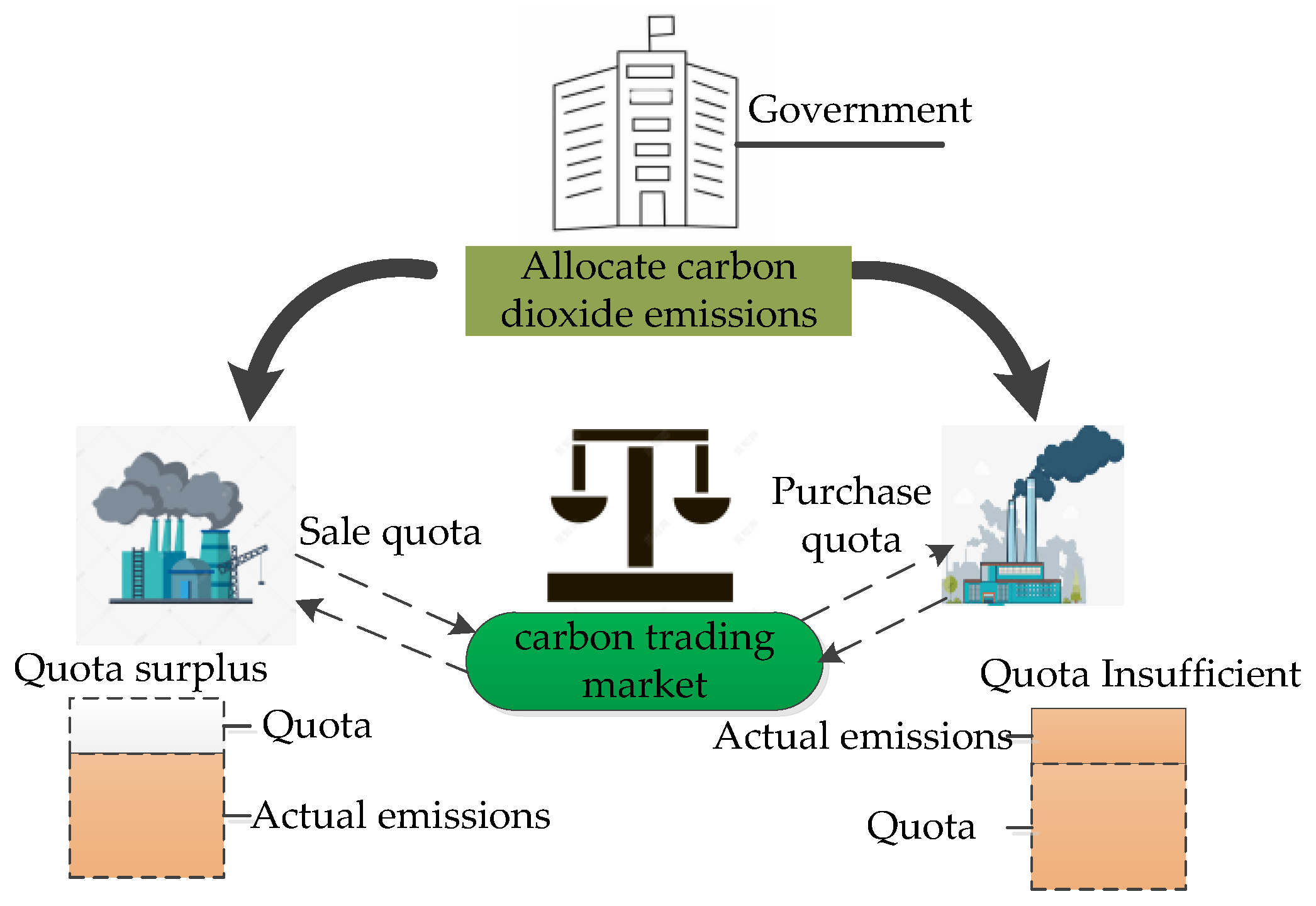
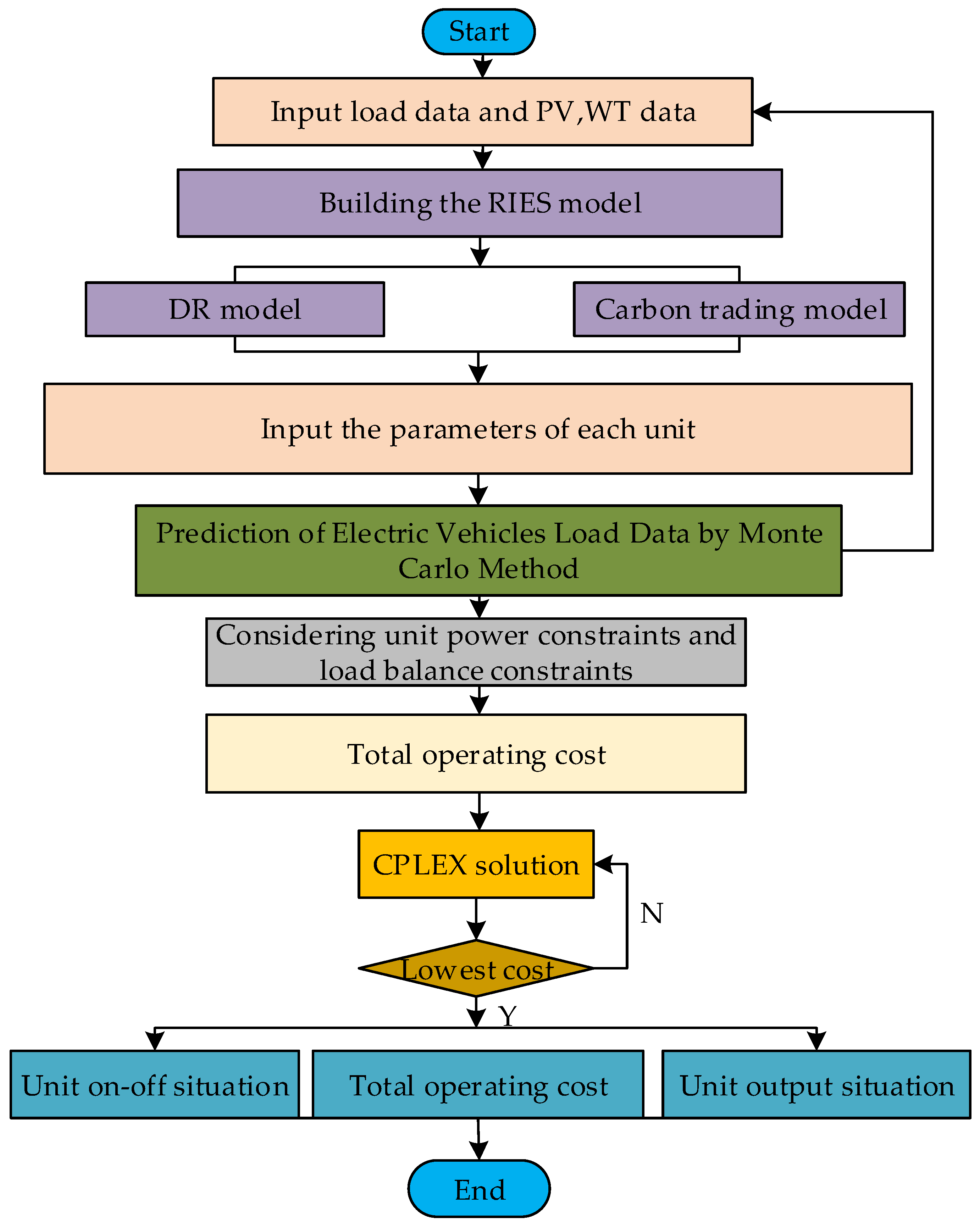
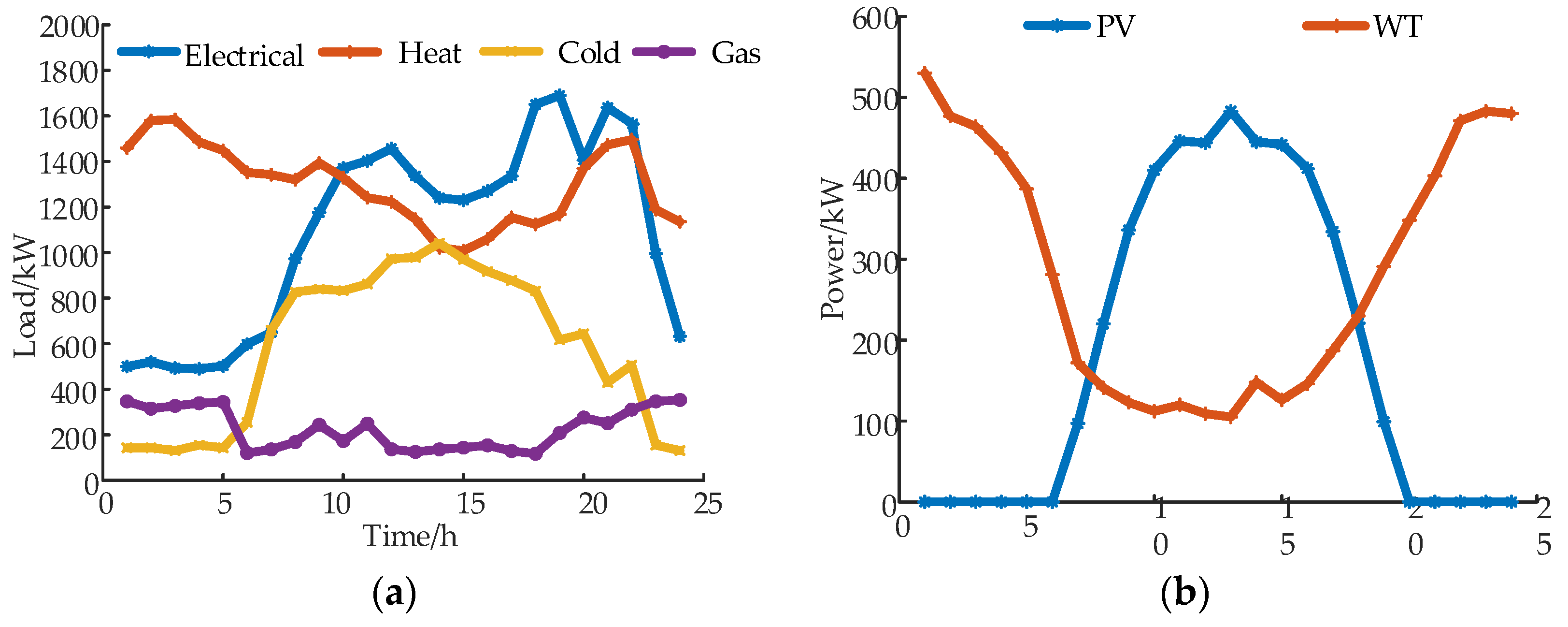


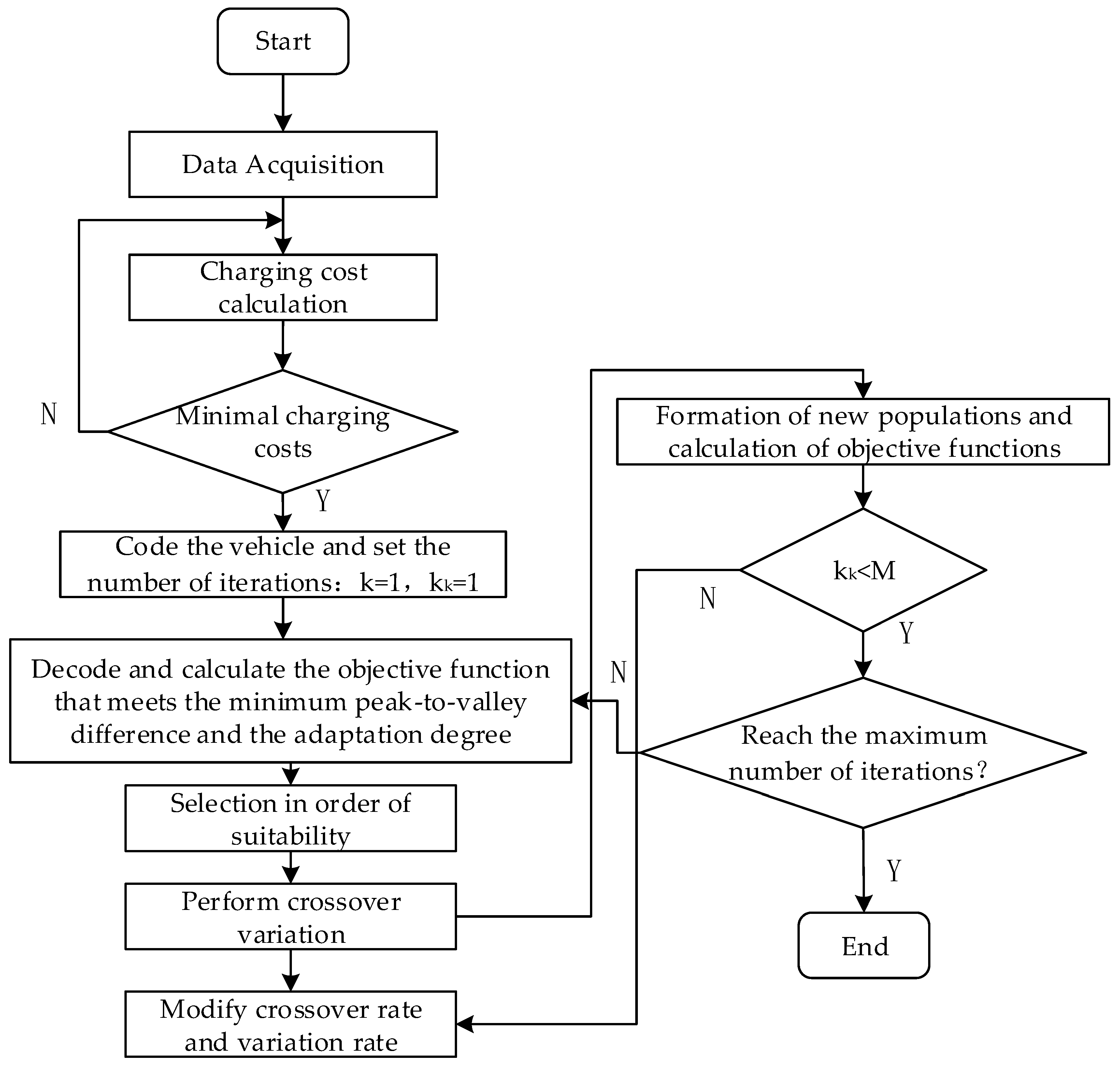
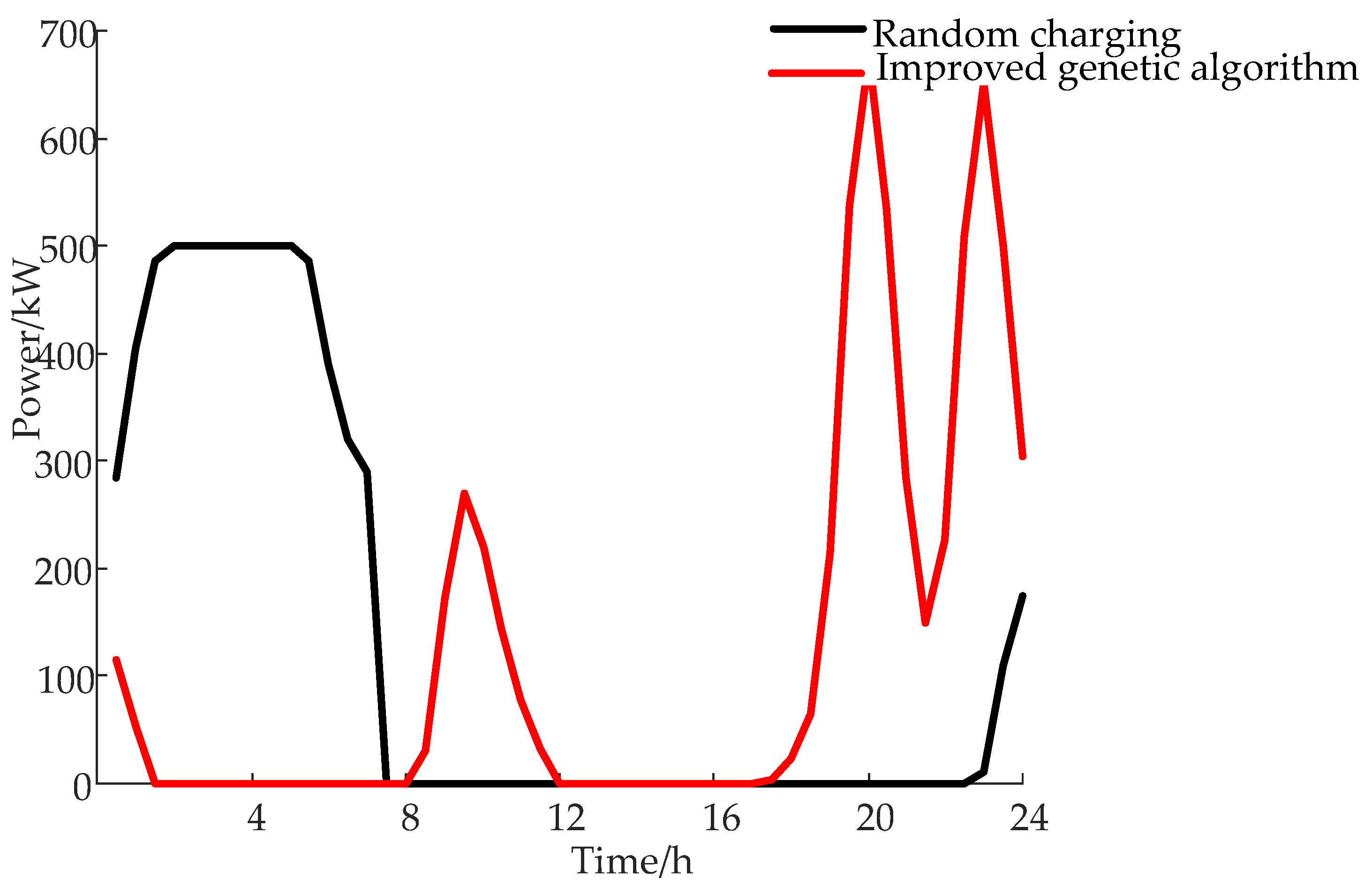
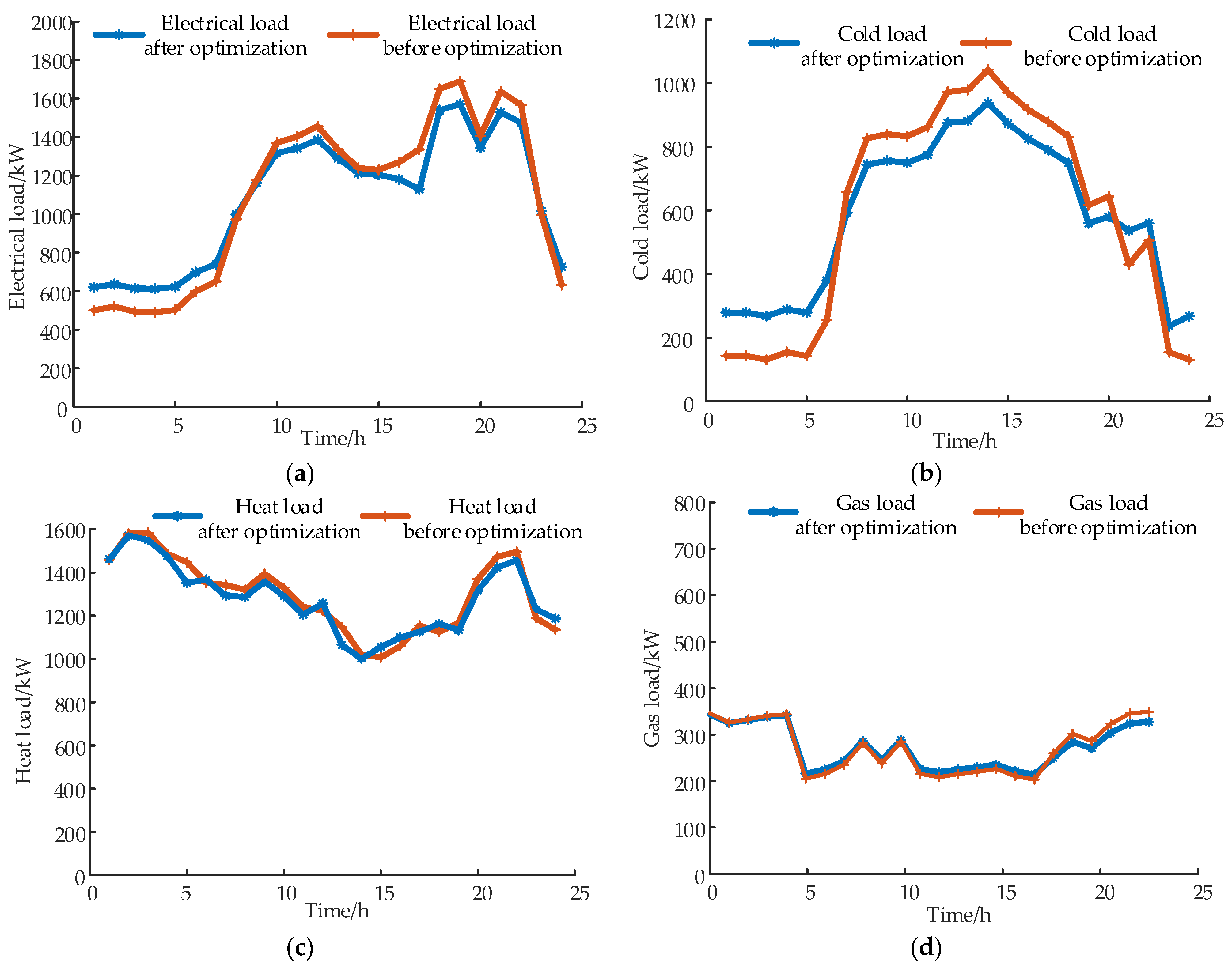
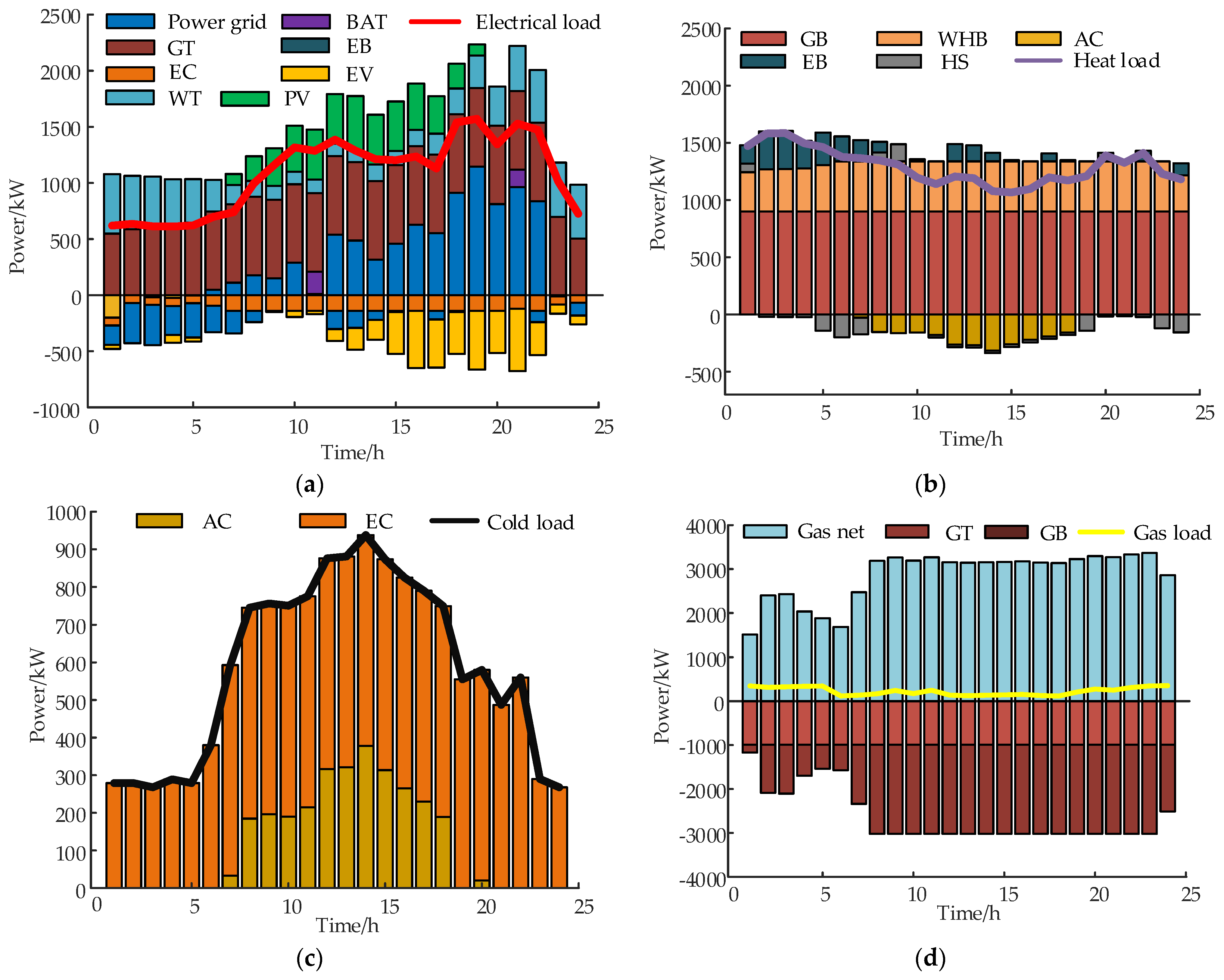
| Equipment Name | Parameter Type | Value (kW) |
|---|---|---|
| GT | output power thermal/electrical power | [0, 700] 0.45/0.35 |
| GB | output power thermal efficiency | [0, 900] 0.9 |
| EC | output power | [0, 560] |
| AC | output power | [0, 600] |
| maximum capacity initial capacity charge/discharge rate, self-loss rate | 800 300 0.9/0.9, 0.1 | |
| EB | output power heating efficiency | [0, 500] 0.93 |
| SL/CL | proportion | 20%/10% |
| Operating Mode Type | Operating Mode |
|---|---|
| model 1 | no demand response and carbon trading mechanism |
| model 2 | only demand response |
| model 3 | only carbon trading mechanism |
| model 4 | both demand response and carbon trading mechanisms |
| Time Period Type | Time Period | Electricity Purchasing Price (Yuan) | Electricity Selling Price (Yuan) |
|---|---|---|---|
| low period | 00:00–8:00 | 0.4 | 0.3 |
| normal period | 8:00–9:00 12:00–19:00 22:00–24:00 | 0.8 | 0.55 |
| peak period | 9:00–12:00 19:00–22:00 | 1.5 | 1.3 |
| Type of Pollutant | Pollution Charge (Yuan/kg) | Pollution Emission Factor/(kg/kWh) | ||||
|---|---|---|---|---|---|---|
| PV | WT | GT | GB | P-Grid | ||
| CO2 | 0.018 | 0 | 0 | 0.659 | 0.489 | 0.889 |
| SO2 | 5.950 | 0 | 0 | 0.000216 | 0.003 | 0.0018 |
| NOx | 8.510 | 0 | 0 | 0.01 | 0.008 | 0.0016 |
| Scenario Type | Total Operating Cost/(Yuan) | Operation and Maintenance Cost/(Yuan) | Carbon Trading Cost/(Yuan) | Cev/(Yuan) | Energy Purchase Cost/(Yuan) | Pollution Control Cost/(Yuan) |
|---|---|---|---|---|---|---|
| Scenario 1 | 31,856.56 | 2821.99 | 1322.37 | 0 | 27,383.07 | 121.55 |
| Scenario 2 | 29,906.87 | 2819.57 | 1433.87 | 0 | 25,521.80 | 131.63 |
| Scenario 3 | 28,003.41 | 3002.58 | 298.31 | 545.47 | 25,111.98 | 136.03 |
| Scenario 4 | 26,718.93 | 3216.89 | 258.52 | 555.54 | 23,634.04 | 135.02 |
Disclaimer/Publisher’s Note: The statements, opinions and data contained in all publications are solely those of the individual author(s) and contributor(s) and not of MDPI and/or the editor(s). MDPI and/or the editor(s) disclaim responsibility for any injury to people or property resulting from any ideas, methods, instructions or products referred to in the content. |
© 2023 by the authors. Licensee MDPI, Basel, Switzerland. This article is an open access article distributed under the terms and conditions of the Creative Commons Attribution (CC BY) license (https://creativecommons.org/licenses/by/4.0/).
Share and Cite
Zhang, Y.; Liu, Z.; Wu, Y.; Li, L. Research on Optimal Operation of Regional Integrated Energy Systems in View of Demand Response and Improved Carbon Trading. Appl. Sci. 2023, 13, 6561. https://doi.org/10.3390/app13116561
Zhang Y, Liu Z, Wu Y, Li L. Research on Optimal Operation of Regional Integrated Energy Systems in View of Demand Response and Improved Carbon Trading. Applied Sciences. 2023; 13(11):6561. https://doi.org/10.3390/app13116561
Chicago/Turabian StyleZhang, Yu, Zhongxiang Liu, Yuhu Wu, and Lianmin Li. 2023. "Research on Optimal Operation of Regional Integrated Energy Systems in View of Demand Response and Improved Carbon Trading" Applied Sciences 13, no. 11: 6561. https://doi.org/10.3390/app13116561






